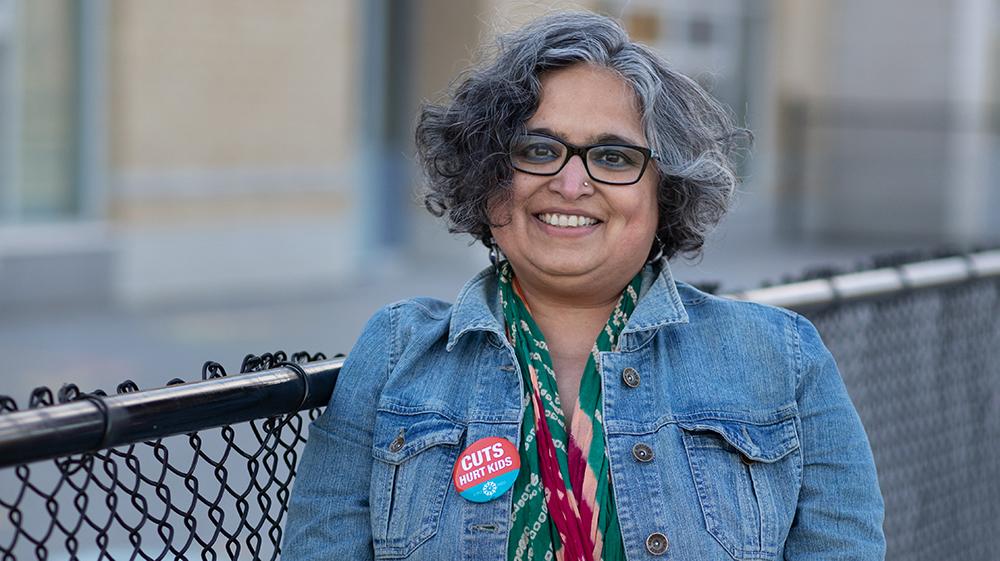
Mothers and Teachers: Two Sides of the Same Coin?
In 2005, as a second-year teacher in a GTA public school, I wrote, “My Indian-ness comes to me far away from home. It comes to me when people speak to me LOUDLY, so I understand.”
I was sitting in a sun-filled staff room in May, confused after being asked repeatedly “What shall we do for South Asian Heritage Month?” Since my family’s arrival in the GTA in January 2002, I had begun to realize that my presence in my new home, Ontario, was one that came with many labels, some of which I did not even see. I had begun to notice how I received nods from teachers and others on supervision duty when I waited for my daughter outside her school. But when I worked at my school, people would engage with me conversationally. When I visited my children’s schools, or other schools in my school board for professional development, I would be asked if I was the lunch lady. As these are the people who watch over student safety during unstructured and semi-structured times, I did not mind at all. It was amusing though to see the back-pedalling when people realized that I was “the teacher” or “the presenter” at the professional development.
Now as a K-12 Special Education Consultant, when I visit schools in which I am “the only one,” these experiences are recurrent. Students also come up to me and ask, “So, what are you? Where were you born? Where are your parents from?” I observe these experiences as they bring to light how I am seen in social-professional-academic spaces.
Mother-Teacher: The Blended Standpoint
My experiences with my children’s schooling improved gradually as I went from being a “newcomer” to becoming an Ontario certified teacher and it is through the careful navigation of the schooling landscape as mother-teacher-racialized “South Asian” woman that I began to make meaning and breathe better. As I have seen my status become elevated through 19 years of living here gathering academic and professional credentials alongside a social media presence, I continue to realize that women who look like me and talk like me, when devoid of the power labels I bear, do not experience the schooling of their children in the same way that I did.
When I engage in social, professional and academic spaces, I do so as a racialized woman whose spoken words bear the fragrance of many languages of which English is one. When I teach, engage in community work, listen to professional development presentations or, in my role as a K-12 Special Education consultant, design and deliver professional learning, I inhabit what I have come to see and name as my blended standpoint. This is a conscious space in which the mother and teacher stand side-by-side and look at the educational landscape in which our work unfolds alongside those seen and unseen others in the lives of the children/ students in our care.
Parental Engagement or Mothering Work
Ontario’s Parental Engagement Policy states that when “parents are engaged and involved, everyone – students, parents and families, teachers, schools and communities – benefits, and our schools become increasingly rich and positive places to teach, learn and grow.” These words reappear in all K-12 curriculum documents where the expectation of parental engagement changes depending on the age of the child. These documents also assign the responsibility of engaging parents to teachers. This becomes an inextricable aspect of our work irrespective of the demands on the families with whom we are partnered for the educational outcomes of their children.
Conversations around parents’ experiences in schools are dependent on the ways in which they are welcomed and respectfully acknowledged as contributors to their children’s educational outcomes. Teachers’ work unfolds in a landscape where issues of everyday racism and sexism can co-exist alongside good intentions: this is an oft-invisibilized understanding to which we need to pay close attention.
Research shows that the work of parenting, though portrayed as gender-neutral labour, is largely done by women in the homes of our students. Mothering Work, a term coined by Canadian sociologists Alison Griffith and Dorothy Smith, draws attention to the invisibilized work of women done in families that is tacitly required by formal schooling. It is well known in scholarly literature and everyday observations that the lived realities of families are not identical, but due to the uniformity of educational standards, the expectation that all parents need to match up to a standard that is set by society is one that informs everyday work. It is also well documented in research that in spaces where the demands of time and material resources are reduced, teachers step up and do this work, taking on the role that is expected to be fulfilled in the home. That there is no time and additional funding nor acknowledgement for this supplementary work comes to light in an important report called The School Context Model published in 2014. The role that teachers play is also highlighted here.
Professor Nina Bascia, Chair of the Leadership, Higher and Adult Education department at the Ontario Institute for Studies in Education (OISE) at the University of Toronto, writes that teacher communities have a strong and positive impact on students’ outcomes when teachers participate in professional learning communities alongside their colleagues as this allows them to broaden their pedagogical repertoires.
The Gap in Educational Work
The Parent Engagement Policy speaks of parental involvement as the critical aspect of student outcomes. Yet, there is much research that addresses the ways in which systemic racism percolates into lives of students and families and impacts educational opportunities. People for Education’s 2014 report Applied or Academic: High Impact Decisions for Ontario Students speaks of how teachers’ professional judgement is cited as a key determinant for students’ high school course selection instead of the Individual Pathways Plan being used to inform these decisions. The 2017 report, Towards Race Equity in Education, highlights ways in which Black students are nudged into low-yield pathways. Streaming continues to be a concern in Ontario and the conversations around this critical aspect of distribution of opportunities is one that needs to begin in Kindergarten as pathways germinate early in the education policy arena.
Although we observe, experience, read about and speak of how the work in homes is labelled in a gender-neutral, race-class neutral manner without much notice paid to linguistic privilege, it is important that many education workers lead the way to inform social change. We can begin by acknowledging that in the Western world, including Canada, as well as in the global educational landscape, the notion of ideal parental engagement is pervasive and powerful.
Much research highlights the ways in which every day hallway conversations frame students and families and create a story that guides the perception about them in educational work sites such as schools. The Standard North American Family, says Smith, is an ideological code that informs the biases by which we see particular families as deficient because the ideal of SNAF is a two-parent, heterosexual family where the father’s work allows the mother to attend to the children’s schooling and educational outcomes. It is also important to notice that race is a critical intersection within SNAF. Canadian parent engagement researcher, Dr. Debbie Pushor, speaks of parent knowledge as a partner to schooling. Educators in Ontario need to be aware of these key aspects.
Standing Beside and Walking With
Teachers’ and educational workers’ experiences are valuable. Through our professional expertise, our social justice and anti-oppression learning as well as our ongoing collaborations across demographics, we can lead the way to make a dent in the demands placed on families, rather women, who as mothers, grandmothers, aunts, sisters and extended family members work alongside us in educational settings in physical and virtual spaces.
The Elementary Teachers Federation of Ontario has created room for education workers to rely on data-driven decisions through the Understanding Your Professional Judgement resource. It states that, “As an educator exercising your professional judgement, you should be prepared to provide rationale for the decisions you make, if asked.” It is therefore critically important to use authentic professional judgement as outlined in this resource when engaging with students and families across all school contexts. By holding up a mirror to our daily practice, ETFO members can continue to play a critical role in dismantling systemic racism. Through asset-based engagement with families across all demographics and socio-economic strata throughout the province of Ontario, we can continue to be agents of social change. As the need for ongoing parental engagement and authentic collaborations across diverse communities continues to be brought to light as a policy gap, it is critical for educational workers who seek to be front runners in social change to engage with meaningful mentoring networks. This self-directed learning can support and scaffold reflective professional dialogue.
Mothers and teachers are not two sides of the same coin: we can stand beside one another to look back at social inequities as we work together for equitable educational outcomes for the students in our care. The first step therefore is to improve our individual and collective consciousness so that we begin and continue to respect the lived realities of all mothers as partners in educational work. The blended standpoint is a mirror that allows us to see ourselves clearly as we stand with and walk beside mothers while asking the key question “If this were my child, what would I do, wish for and fight for.”
Dr. Rashmee Karnad-Jani is a member of the York Region Teacher Local.

